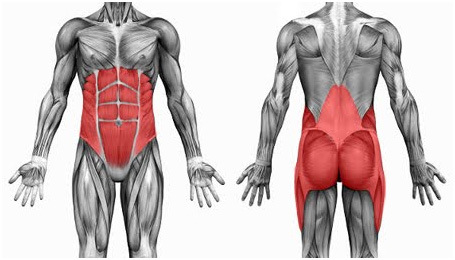What?? You don't do sit-ups?
Nothing drives me crazier than getting asked what my favorite ab exercise is. Maybe I just really dislike vanity, but more likely, I think my dislike for "ab" exercises comes from the fact that most people just don't understand what the core is, and specifically what it's function is. The other day, I came across this definition of the core that sheds light onto what I'm talking about:
"The core can be viewed as a box with the abdominals in the front, the paraspinals and glutes in back, the diaphragm as the roof of the box, and the pelvic floor and hip girdle as the bottom of the box. (1)"

That box of musculature has a very specific funtion - to stabilize the spine and to distribute forces appropriately. That's a pretty serious job! Now remember, the core is the link between the upper body and the lower body. The core must be stable so that the hips and thoracic spine can be mobile. Keeping the core stable allows for greater force to be produced in both the upper and lower body. Do you think crunches and sit-ups get 5 stars for their ability to perform this specific job? No way! We need to think of the role of the core, and train specifically for that. Eric Cressey, owner of an amazing baseball facility in Massachusetts, did a great job categorizing these issues for us.
1.) Lateral core stability (resisting lateral flexion)
I know this sounds very “exercise sciency”, but we are really just talking about having the strength to resist movement from side to side. We want our bodies to be efficient at resisting lateral flexion in the lumbar spine. The lumbar spine should only contribute up to 27 degrees of flexion, while the thoracic spine is capable of contributing up to 75 degrees (3). The most basic exercise for lateral core stability is the side plank. Side planks are a great exercise to improve this, but the issue is that a lot of baseball/softball players have some underlying shoulder conditions that become pretty painful while performing a side plank. A good option for those athletes is doing a feet supported plank. This alleviates pressure off the shoulder because the athlete will be hanging off a bench. This is a challenging exercise, but can be modified for athletes. Do 5 second holds to start, and progress to 30 second weighted holds.
Lateral core stability exercises
Another go-to exercise to teach an athlete to resist lateral flexion is a suitcase carry. The exercise basically speaks for itself – grab a heavy weight, and carry it around like a suitcase. The weight is obviously going to try to pull you sideways, so you have to resist the pull.
2.) Rotary core stability (resist excessive rotation in lumbar spine)
I refer to these as anti-rotation exercises, and they basically train the trunk to resist rotation. Now this may seem counterintuitive at first since baseball/softball players need to be exceptional rotators. However, creating strength through anti-rotation exercises also produces strength in rotational movements. Also, think about where the rotation comes from while swinging a bat. The swing doesn’t come from excessive movement in the lumbar spine, rather the rotation occurs through the hips and the thoracic spine. In fact, rotation at the lumbar spine only contributes 13% of total spine rotation (3).
Watch the videos here: Rotary core stability
Cable columns are great for anti-rotation exercises, however not everyone has access to them. Bands are a good substitute for these with my favorite being a simple banded anti-rotation progressed to the Pallof press. The MB woodchop is a good exercise to begin with to teach stability in the lumbar spine and movement in the hips and shoulders. It’s not one of my favorite exercises though, because athletes tend to just make it look like they are either swinging a bat or golf club.
3.) Anterior core stability (resist excessive lumbar spine extension)
Fancy word for working on the muscles in your front side (anterior = front side, posterior = back side). Planks are the basic form of anterior core work, but can be progressed in many ways. Really, the possibilities are endless. These are great for those athletes who have an exagerated anterior pelvic tilt, which we talked about in the glute activation article.
Watch the videos here: Anterior core stability
4.) Posterior core stability (resist excessive lumbar spine flexion)
Fancy word for working on the muscles in your back side. The bird dog exercise is the simplest form, but many traditional heavy leg lifts are great for posterior core stability. Think deadlift, RDL’s, back squat, front squats… lots of exercises.
Most exercises will fall into several of these categories. In a later post, we will look how to combine some of the things we have talked about like glute activation and core stability to make a well rounded strength program.
References:
(1) Michael Fredericson & Tammara Moore: Muscular Balance, Core Stability,and Injury Prevention for Middle- and Long-Distance Runners (2005). Physical medicine and rehabilitation clinics of North America.
(2) Ericcressey.com - Core stability exercises
(3) Shirley Sahrmann - Diagnosis and treatment of movement impairments

